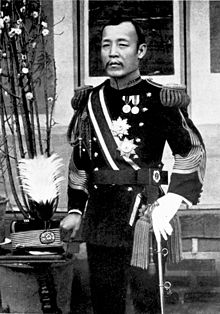Min Young-hwan
This article needs additional citations for verification. (June 2009) |
| Min Young-hwan | |
 | |
| Korean name | |
|---|---|
| Hangul | 민영환 |
| Hanja | |
| Revised Romanization | Min Yeong-hwan |
| McCune–Reischauer | Min Yŏng-hwan |
| Courtesy name | |
| Hangul | 문약 |
| Hanja | |
| Revised Romanization | Munyak |
| McCune–Reischauer | Munyak |
| Posthumous name | |
| Hangul | 충정 |
| Hanja | |
| Revised Romanization | Chungjeong |
| McCune–Reischauer | Ch'ung-jŏng |
Min Young-hwan (1861–1905) was a minister of the Korean Empire and known as a conservative proponent for reform. He was born in Seoul into the powerful Min clan and committed suicide as an act of resistance against the Eulsa Treaty imposed by Japan on Korea. He was a nephew of Empress Myeongseong. He is remembered today for his efforts on behalf of Korean independence in the waning days of the Joseon dynasty and a statue to his memory now stands near the gates of Seoul's Changdeok Palace.
Biography
Min's father, Min Gyeomho (민겸호, 閔謙鎬) was a minister in the Ministry of Finance (Hojo). Min Young-hwan passed the Gwageo examination in 1878 and thereupon entered into government service as a junior librarian in the Royal Library (Gyujanggak).".[1] Min continued to rise through the ranks of Joseon officialdom, holding a succession of posts including a position in the Office of Special Advisors (Hongmungwan 弘文館) and tutor to the Crown Prince. In July 1882 Seoul was shaken by the Soldier's Rebellion triggered by the disgruntled royal palace guards who had not received their wages for several months. During this revolt Min's father was killed. As a result, Min resigned his posts and went into mourning. In 1884, Min reentered public service and was appointed an official of the Board of Personnel (Ijo 吏曹) and successively held various government posts, such as Vice-mayor of Seoul (Hanseong Uyun 漢城右尹). In 1895, Min was appointed as the first ambassador to the United States. However, the murder of his aunt, the Empress Myeongseong, by Japanese troops in October 1895, prevented his taking up the post. In April 1896, Min was appointed special ambassador and sent to Russia to attend the coronation of Czar Nicholas II. After a six month journey Min returned to Korea in late October of the same year. In January 1897, Min was again sent to Europe as Korean envoy to the Diamond Jubilee of Queen Victoria. These journeys served to further convince Min of the necessity of modernization. Upon his return to Korea, Min was an active supporter of the Independence Club, and was interviewed by its newspaper The Independent (Dongnip Sinmun 獨立新聞) .

On November 17, 1905, Japan succeeded in foisting upon Korea the Eulsa Treaty making Korea a Japanese protectorship. It is said that upon hearing of the treaty three days after it had been concluded, Min "fainted several times and vomited blood."[2] Min and many other officials pleaded with King Gojong to annul the treaty and execute the five Korean officials who had signed it, now widely referred to as the "Five Traitors of Eulsa" (Eulsa ojeok). But, his remonstrances silenced by Japanese force, Min decided to commit suicide as a final act of resistance and protest by a loyal official. On November 30, 1905 Min cut his own throat. After this death, in his pockets were found five identical messages on the back of his calling cards to the representatives of China, Great Britain, the United States, France, and Germany in which he pleaded with those powers to recognize the true situation within Korea. He also left a final message directed towards the people of Korea (see below), in which he promised to help his fellow countrymen "from the nether world" if they would strengthen their collective will and spirit and exercise their learning in an all out effort to "restore our [Korean] freedom and independence."[3]
Some officials, including Jo Byeongse, Hong Mansik, Yi Sangcheol, and even Min's rickshaw puller, committed suicide following Min's death. Others, perhaps inspired to action by Min's death, joined righteous armies (uibyeong). Min was posthumously conferred with the army's highest rank.
In 1962 Min was again posthumously awarded the Order of Merit for National Foundation.
Blood Bamboo
One year after Min's death, it was widely reported that a bamboo plant appeared where his bloody clothes had been laid. Many people thought the bamboo grew nurtured by Min's blood so that the bamboo was called Hyeoljuk (血竹), or "Blood Bamboo". Amazingly, the number of its leaves was 45, Min's age at the time of his death.
Following its discovery people crowded to witness this bamboo, some taking pictures. The Japanese government thought it was either a natural phenomenon or pure fabrication and sent officials to Min's former home to investigate. Mysteriously, they discovered the bamboo had no roots and was proven not to be fabricated [citation needed]. The Blood Bamboo was preserved and is now housed at the Korea University Museum along with items of Min's clothing and other personal effects.
In East Asian tradition bamboo is a symbol of loyalty and uprightedness.
References
- ^ Michael Finch (translator), Min Yǒnghwan, The Selected Writings of a Late Chosǒn Diplomat. (Berkeley, CA: Institute of East Asian Studies, 2008), 4.
- ^ Michael Finch (translator), Min Yǒnghwan, The Selected Writings of a Late Chosǒn Diplomat, 24.
- ^ Michael Finch, Min Yǒng-hwan, A Political Biography (Honolulu, HI: University of Hawaii Press, 2002), 175.
